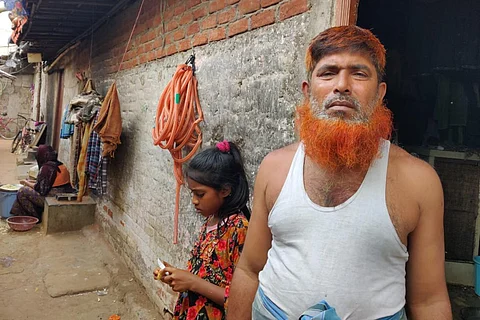

This story is a part of the TNM COVID-19 reporting project. To support this project, make a payment here.
Zuhura Begum, a 32-year-old Rohingya refugee living in Hyderabad’s Balapur, died on May 23 due to COVID-19, but according to Save the Children, who are working along with United Nations High Commissioner for Refugees (UNHCR) – overseeing the safety, protection and welfare of refugees – they have no record of her death. According to the Save the Children organization, there have been zero deaths due to the pandemic since March 2020 in the Balapur camps.
Zuhura was a resident of Royal Colony in Balapur, which is one of the biggest refugee settlements in India. There have been many such suspected COVID-19 deaths in refugee camps, but stigma and fear has forced the Rohingya community members to hide these deaths, says Iliyas Nadwi, Zuhura’s relative. “In one camp itself I know three persons who died, but no one reveals anything about these deaths fearing social stigma and the possibility of that family infecting others in the camp,” Iliyas adds.
Rohingyas are a linguistic and ethnic group who faced systematic persecution by the Buddhist-majority Myanmar, as a result of which many of them fled to neighbouring Bangladesh and India. They are classified as the “most persecuted minority in the world” by the United Nations. They are stateless as they are denied citizenship by Myanmar who see them as “illegal immigrants from Bangladesh.”
A refugee camp in Balapur
In Balapur, there are around 40 refugee camps housing 1,500 families consisting of nearly 5,000 people. These camps are cramped and densely populated and share common toilets, thus the luxury of social distancing and home isolation is a utopian dream. “Acknowledging this, last May itself we started a drive about the need to practise COVID-19 safety protocols. These safety instructions are in their own language too for their convenience,” says Vikas Gora, Deputy Director (South), Save the Children project, which is part of the UNHCR. “There have been some deaths related to old age, but no COVID-19 deaths,” he adds.
The poor refugees live in extremely unhygienic and unsanitary conditions, often suffering from malaria and typhoid, and it is hard to identify if they have contracted COVID-19. “We don’t even know how many were under home isolation,” Vikas says.
Children helping their families earn income by peeling ginger skin
The refugees mostly work as construction workers. Though they are under high risk of contracting COVID-19 because of lack of space in the camps and ignoring the need to wear masks, they will potentially be the last group to get the COVID-19 vaccine. Prioritising the frontline and healthcare workers, the first phase of the country-wide vaccination began on January 16. The Telangana government is yet to fully vaccinate Indian citizens living in the state.
Mohammed Nazir, a refugee from camp 2, says, “So far none of us have tested positive for coronavirus in the camps, but we are scared. If the authorities enable vaccination, we will take it. We have many small kids in the camps.”
According to Telangana Director of Public Health Dr G Srinivasa Rao, as of June 6, only 52 lakh people have been inoculated. Due to unavailability of vaccines and the Union government’s failure to foresee a second wave of the pandemic, the COVID-19 vaccination programme is going alarmingly slow. According to some studies, it would take another 2.5 years for the Indian government to cover 75% of the population. As of now the COVID-19 vaccination for Indian citizens is done through the centralised Co-Win portal, by mandatorily registering with the Aadhaar card – a 12-digit individual identification number issued by the Unique Identification Authority of India.
As many families are deprived of daily jobs due to the lockdown, these refugee families are making a living by peeling ginger and garlic skin
However, acknowledging the human crisis, the Telangana government has decided to speed up the process of vaccinating refugees too. “We will soon start vaccinating them also, without the need of an Aadhaar card,” Dr Srinivasa Rao told TNM. As of now, none of the refugees have been able to avail the vaccine, says Vikas.
With children constituting half the refugee population, UNHCR representatives are worried about another wave of the novel coronavirus. “We’re preparing for a possible third wave by equipping peripheral hospitals in the vicinity of Balapur with adequate medical equipment,” says Vikas. “In another two months, we will make vaccination possible for the age group of 45 and above, where they can show their United Nations refugee card and get vaccinated,” he says.
TNM COVID-19 Reporting Project is funded by our readers. We would like to thank the following people for making this story possible: K Bhaskar, Ganesh Chakravarthi, Krithika Muthuraman, Nishant Radhakrishnan, Abhirami Girija Sriram, Yogeesh Prabhuswamy, Shravan Kumar, Parthiban Ammamuthu, Alexander Babu, Joseph Manoj, R Bhagwan Singh, Laya & Advaith, Devnath M and many others.
You can support us through this link.
Other stories done with the help of TNM readers:
Shuttered schools have left van drivers and other contract workers without income
No final touch or kiss: Funerals of COVID-19 victims are more painful for families
Bengaluru's railway porters struggle to make ends meet during second wave